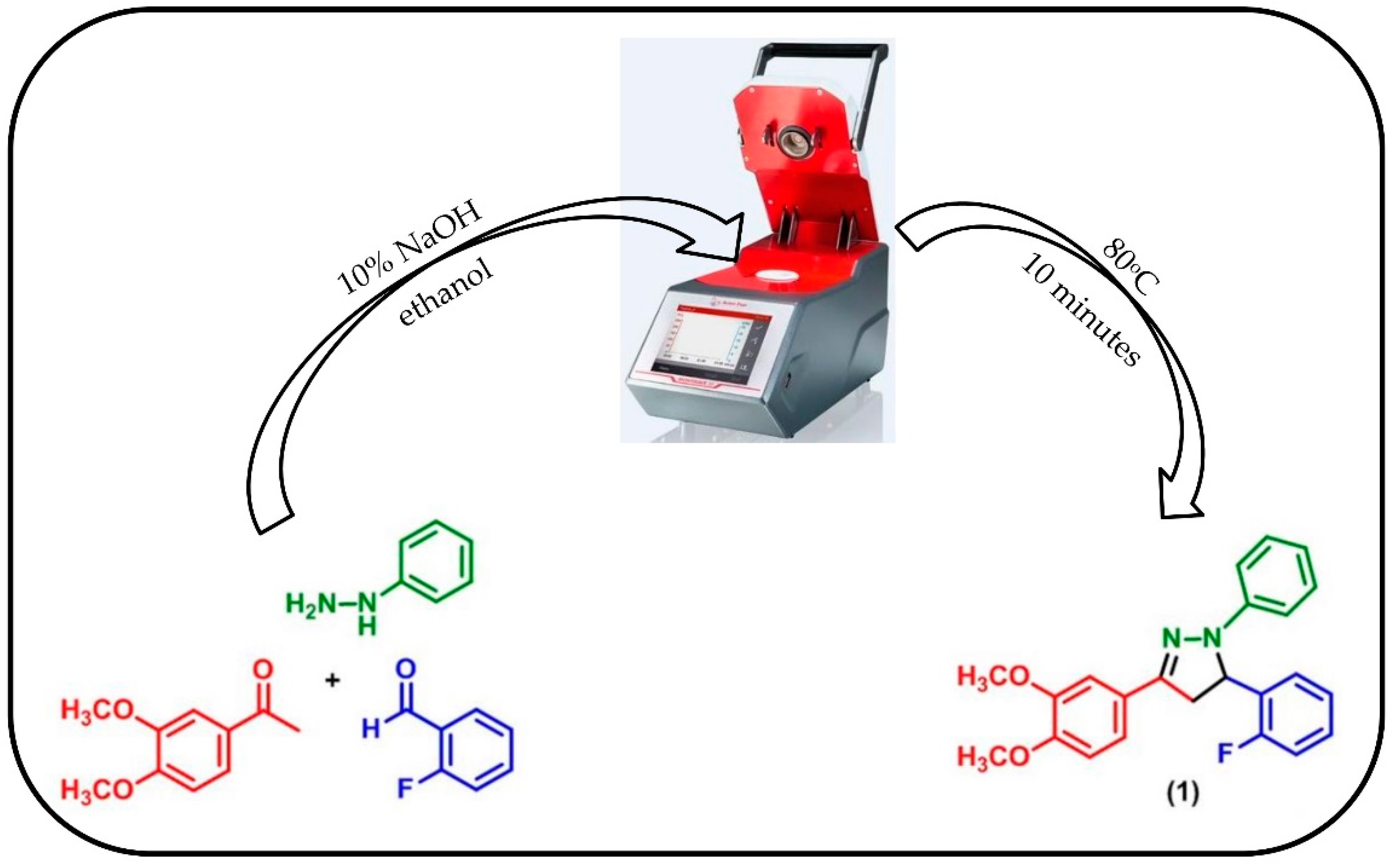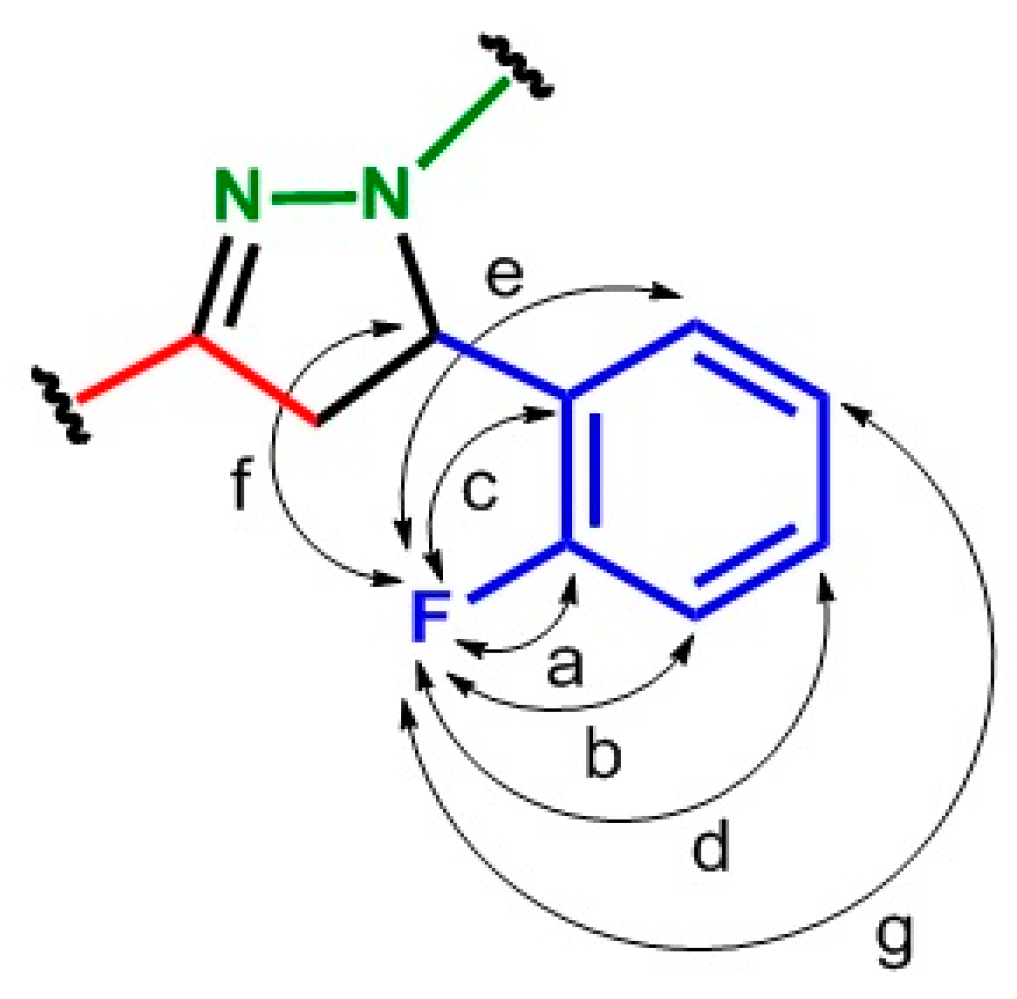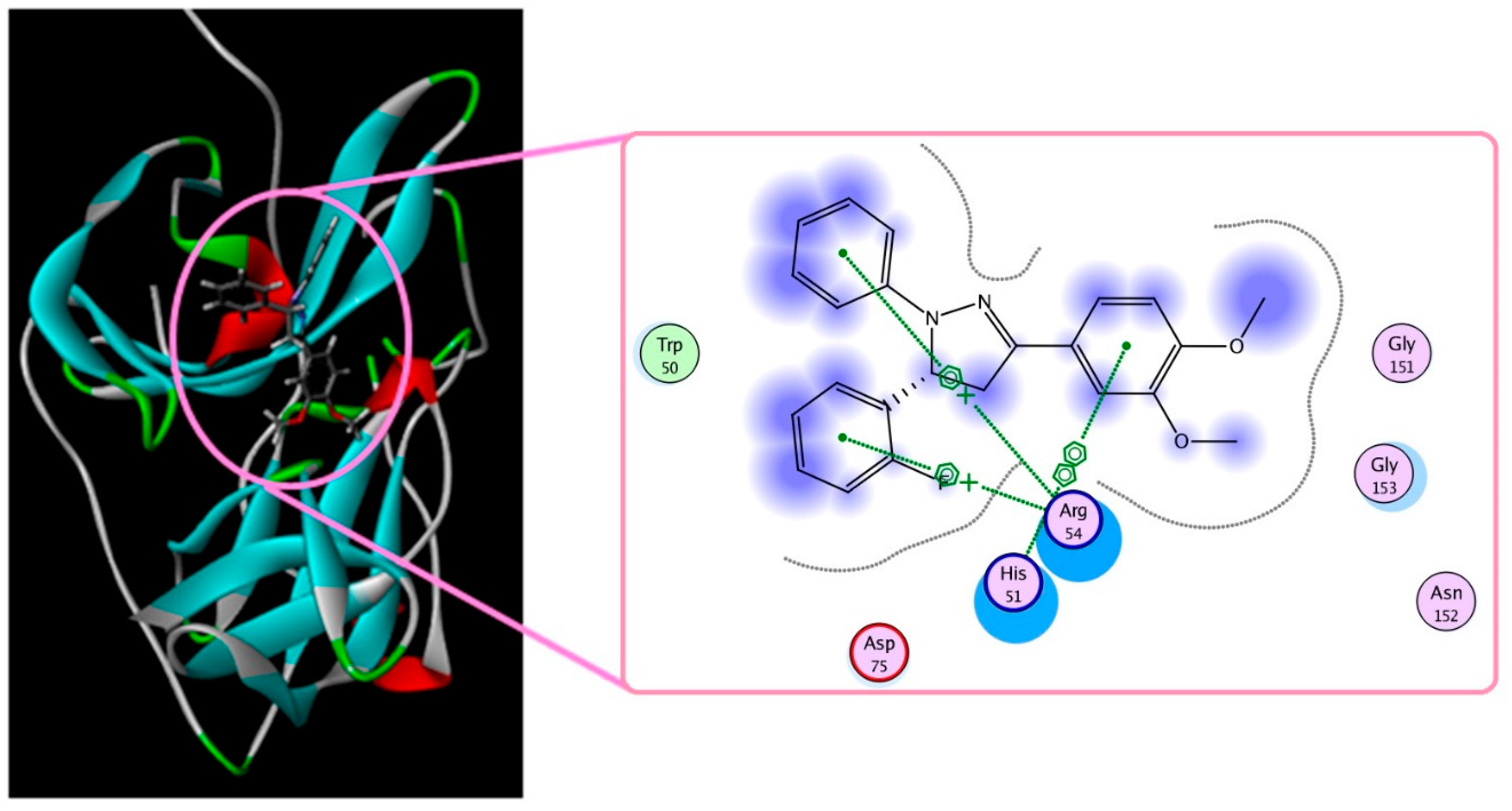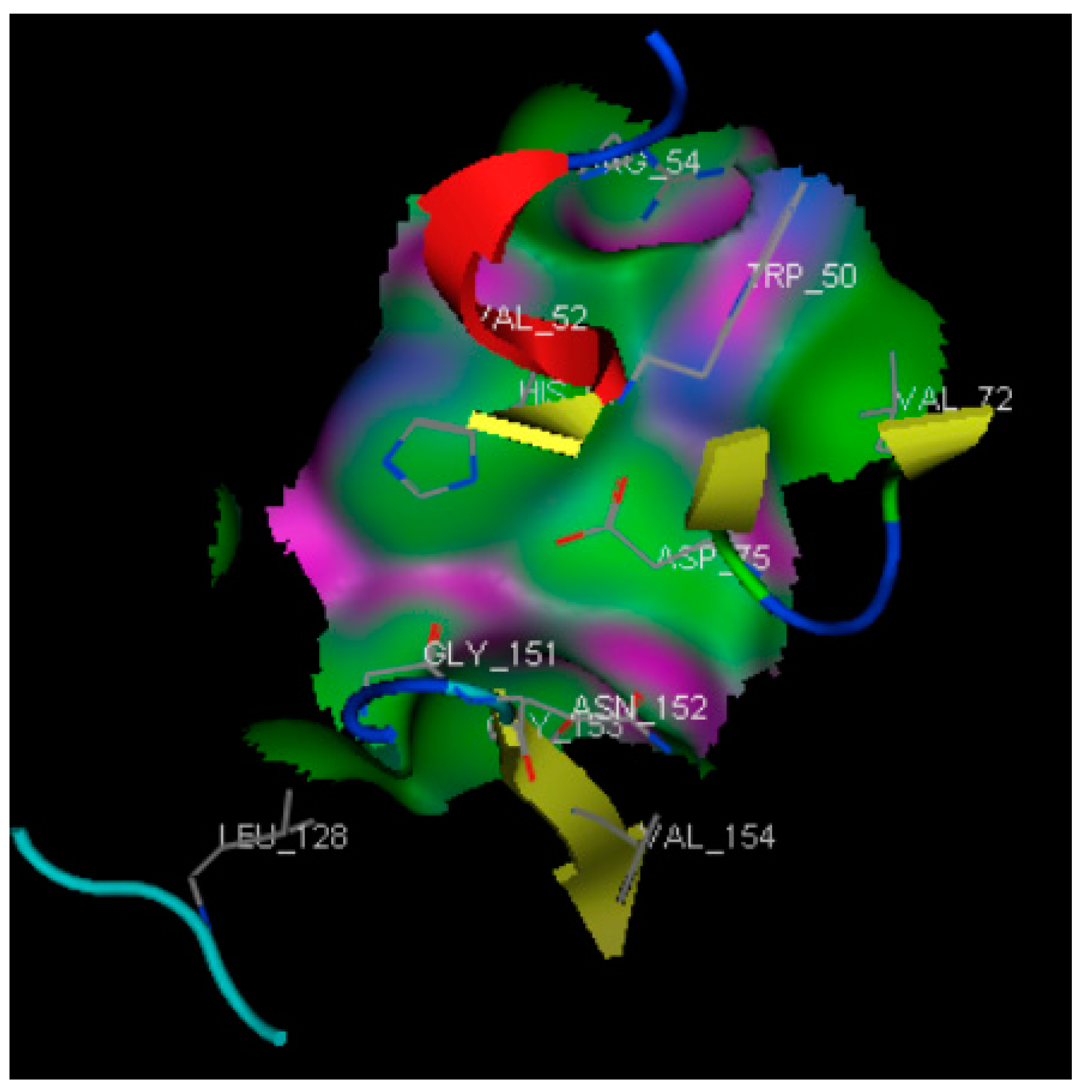3-(3,4-Dimethoxyphenyl)-5-(2-fluorophenyl)-1-phenyl-4,5-dihydro-1H-pyrazole
Abstract
1. Introduction
2. Results and Discussion
2.1. Synthesis of Compound 1
2.2. In Silico Studies of Compound 1
3. Materials and Methods
3.1. General Information
3.2. Synthesis of 3-(3,4-dimethoxyphenyl)-5-(2-fluorophenyl)-1-phenyl-4,5-dihydro-1H-pyrazole (1)
3.3. Molecular Docking Study and Molecular Dynamic Simulation
4. Conclusions
Supplementary Materials
Author Contributions
Funding
Acknowledgments
Conflicts of Interest
References
- O’Hagan, D. Understanding organofluorine chemistry. An introduction to the C-F bond. Chem. Soc. Rev. 2008, 37, 308–319. [Google Scholar] [CrossRef] [PubMed]
- Shelke, S.N.; Mhaske, G.R.; Bonifácio, V.D.B.; Gawande, M.B. Green Synthesis and anti-infective activities of fluorinated pyrazolines derivatives. Bioorg. Med. Chem. 2012, 22, 5727–5730. [Google Scholar] [CrossRef] [PubMed]
- Purser, S.; Moore, P.R.; Swallow, S.; Gouverneur, V. Fluorine in medicinal chemistry. Chem. Soc. Rev. 2008, 37, 320–330. [Google Scholar] [CrossRef] [PubMed]
- Yang, W.; Hu, Y.; Yang, Y.S.; Zhang, F.; Zhang, Y.B.; Wang, X.L.; Tang, J.F.; Zhong, W.Q.; Zhu, H.L. Design, modification and 3D QSAR studies of novel naphthalin-containing pyrazolines derivatives with/without thiourea skeleton as anticancer agents. Bioorg. Med. Chem. 2013, 21, 1050–1063. [Google Scholar] [CrossRef] [PubMed]
- Rao, B.S.; Akberali, P.M.; Holla, B.S.; Sarojini, B.K. Synthesis and studies of some new fluorine containing hydroxypyrazolines and 1H pyrazoles as possible antipoliferative agents. J. Pharmacol. Toxicol. 2008, 3, 102–110. [Google Scholar] [CrossRef]
- Koç, G.Ş.; Tan, O.U.; Uçar, G.; Yıldırım, E.; Erol, K.; Palaska, E. Synthesis and monoamine oxidase inhibitory activities of some 3-(4-fluorophenyl)-5-aryl-N-substituted-4,5-dihydro-(1H)-pyrazole-1-carbothioamide derivatives. Drug Res. 2014, 64, 591–598. [Google Scholar] [CrossRef] [PubMed]
- Yusuf, M.; Jain, P. Synthetic and biological studies of pyrazolines and related heterocyclic compounds. Arab. J. Chem. 2014, 7, 553–596. [Google Scholar] [CrossRef]
- Jasril, J.; Zamri, A.; Ikhtiarudin, I.; Teruna, H.Y. 5-(4-fluorophenyl)-3-(naphthalen-1-yl)-1-phenyl-4,5- dihydro-1H-pyrazole. Molbank 2016, 2016, M891. [Google Scholar] [CrossRef]
- Jagadhani, S.G.; Kundlikar, S.G.; Karale, B.K. Synthesis and characterization of some fluorinated 1,5-benzothiazepines and pyrazolines. Orient. J. Chem. 2015, 31, 601–604. [Google Scholar] [CrossRef]
- Lu, B.; Zhang, J.; Wang, M.; Zhou, Y. Synthesis and Fluorescent Property of Pyrazoline Derivatives. Chin. J. Chem. 2012, 30, 1345–1350. [Google Scholar] [CrossRef]
- Manivannan, C.; Santhi, N. Synthesis, characterization and antifugal activity of some fluorine containing 1,3,5-trisubstituted pyrazolines derivatives. World News Nat. Sci. 2017, 10, 86–94. [Google Scholar]
- Alex, K.; Tillack, A.; Schwarz, N.; Beller, M. Zinc-Catalyzed Synthesis of Pyrazolines and Pyrazoles via Hydrohydrazination. Org. Lett. 2008, 10, 2377–2379. [Google Scholar] [CrossRef] [PubMed]
- Hawaiz, F.E.; Hussein, A.J.; Samad, M.K. One-pot three-component synthesis of some new azo-pyrazoline derivatives. Eur. J. Chem. 2014, 5, 233–236. [Google Scholar] [CrossRef][Green Version]
- Hawaiz, F.E.; Chawishli, L.H.; Samad, M.K.; Mohamed, S.K. One Pot Synthesis and Characterization of Some New 1,3,5-Trisubstituted Pyrazoline Derivatives. J. Chem. Pharm. Res. 2017, 9, 185–190. [Google Scholar]
- Chen, D.Z.; Xiao, W.J.; Chen, J.R. Synthesis of spiropyrazoline oxindoles by a formal [4+1] annulation reaction between 3-bromooxindoles and in situ- derived 1,2-diaza-1,3-dienes. Org. Chem. Front. 2017, 4, 1289–1293. [Google Scholar] [CrossRef]
- Patel, N.B.; Shaikh, F.M.; Patel, H.R.; Rajani, D. Synthesis of 2-pyrazolines from pyridine based chalcone by conventional and microwave techniques: Their comparison and antimicrobial studies. J. Saudi Chem. Soc. 2016, 20, S451–S456. [Google Scholar] [CrossRef]
- Thirunarayanan, G.; Sekar, K.G. Solvent-free one-pot cyclization and acetylation of chalcones: Synthesis of some 1-acetyl pyrazoles and spectral correlations of 1-(3-(3,4-dimethylphenyl)-5-(substituted phenyl)-4,5-dihydro-1H-pyrazole-1-yl) ethanones. J. Saudi Chem. Soc. 2016, 20, 661–672. [Google Scholar] [CrossRef]
- Polo, E.; Ferrer-Pertuz, K.; Trilleras, J.; Quiroga, J.; Gutierrez, M. Microwave-assisted one-pot synthesis in water of carbonylpyrazolo [3,4-b]pyridine derivatives catalyzed by InCl3 and sonochemical assisted condensation with aldehydes to obtain new chalcone derivatives containing the pyrazolopyridinic moiety. RSC Adv. 2017, 7, 50044–50055. [Google Scholar] [CrossRef]
- Guo, W.; Wong, T.C. Study of 13C-19F and 1H-19F couplings in some fluorinated aromatic compounds using two-dimensional 13C-1H chemical shift correlation spectroscopy with proton homonuclear decoupling. Magn. Res. Chem. 1986, 24, 75–79. [Google Scholar] [CrossRef]
- Jasril, J.; Ikhtiarudin, I.; Zamri, A.; Teruna, H.Y.; Frimayanti, N. New fluorinated chalcone and pyrazoline analogs: Synthesis, docking and molecular dynamic studies as anti cancer agents. TJPS 2017, 41, 93–98. [Google Scholar]
- Frimayanti, N.; Chee, C.; Zain, S.M.; Rahman, N.A. Design of new competitive dengue NS2B/NS3 protease inhibitors—A computational approach. Int. J. Mol. Sci. 2011, 12, 1089–1100. [Google Scholar] [CrossRef] [PubMed]
- Jasril, J.; Ikhtiarudin, I.; Hasti, S.; Reza, A.I.; Frimayanti, N. Microwave-assisted synthesis, in silico studies and in vivo evaluation for antidiabetic activity of new brominated pyrazoline analogs. TJPS 2019, 43, 83–89. [Google Scholar]
- Zamri, A.; Teruna, H.Y.; Rahmawati, E.N.; Frimayanti, N.; Ikhtiarudin, I. Synthesis and in silico studies of a benzenesulfonyl curcumin analogue as a new anti dengue virus type 2 (DEN2) NS2B/NS3. Indonesian J. Pharm. 2019, 30, 84–90. [Google Scholar] [CrossRef]




| Molecules | Estimated Binding Free Energy (kcal/mol) | Interactions | ||
|---|---|---|---|---|
| Hydrogen Bonds | Van der Waals | Hydrophobic | ||
| Compound 1 | −59.98 | His51, Arg74 | Asp75 | His51, Arg74 |
| Panduratin A | −57.80 a | His51, Gly153 | Gly51 | - |
© 2019 by the authors. Licensee MDPI, Basel, Switzerland. This article is an open access article distributed under the terms and conditions of the Creative Commons Attribution (CC BY) license (http://creativecommons.org/licenses/by/4.0/).
Share and Cite
Zamri, A.; Teruna, H.Y.; Wulansari, S.; Herfindo, N.; Frimayanti, N.; Ikhtiarudin, I. 3-(3,4-Dimethoxyphenyl)-5-(2-fluorophenyl)-1-phenyl-4,5-dihydro-1H-pyrazole. Molbank 2019, 2019, M1088. https://doi.org/10.3390/M1088
Zamri A, Teruna HY, Wulansari S, Herfindo N, Frimayanti N, Ikhtiarudin I. 3-(3,4-Dimethoxyphenyl)-5-(2-fluorophenyl)-1-phenyl-4,5-dihydro-1H-pyrazole. Molbank. 2019; 2019(4):M1088. https://doi.org/10.3390/M1088
Chicago/Turabian StyleZamri, Adel, Hilwan Y. Teruna, Sri Wulansari, Noval Herfindo, Neni Frimayanti, and Ihsan Ikhtiarudin. 2019. "3-(3,4-Dimethoxyphenyl)-5-(2-fluorophenyl)-1-phenyl-4,5-dihydro-1H-pyrazole" Molbank 2019, no. 4: M1088. https://doi.org/10.3390/M1088
APA StyleZamri, A., Teruna, H. Y., Wulansari, S., Herfindo, N., Frimayanti, N., & Ikhtiarudin, I. (2019). 3-(3,4-Dimethoxyphenyl)-5-(2-fluorophenyl)-1-phenyl-4,5-dihydro-1H-pyrazole. Molbank, 2019(4), M1088. https://doi.org/10.3390/M1088








